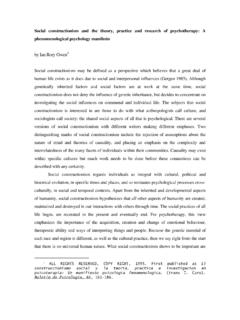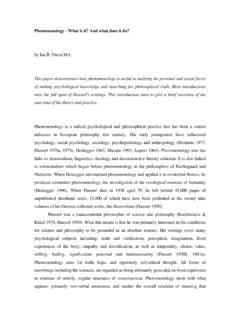Transcription of CORE SKILLS FOR PSYCHOTHERAPY - Intentionality Model
1 core SKILLS FOR PSYCHOTHERAPY . by Ian Rory Owen 1. It is easy to define what therapy is not. It is not lecturing, nor moralizing, patronizing nor befriending. It is not the use of counselling SKILLS by non-mental health professionals in interviewing or management. Some clinical psychologists describe their work as making "clinical psychology interventions", rather than counselling or PSYCHOTHERAPY . Here I am taking the word counselling to mean what the non-psychologist members of the British Association for Counselling practice. I assume that counselling psychology is deeper and wider than BAC. counselling as it takes in both the rationality and inherent criticisms of psychology and the caring of counselling. I am using the word PSYCHOTHERAPY to describe what counselling psychologists do, as I am certain that the work of counselling psychologists requires a commitment to making a high quality relationship with frequently intelligent, sensitive, awkward and critical clients.
2 For ease of presentation I number what I think are the core SKILLS and ground rules of PSYCHOTHERAPY , including the interpersonal qualities of the work. In practice these SKILLS are not separate, but joined together in a seamless fabric. I claim that these core SKILLS are the same for different theoretical approaches and for different client groups. Part of my inspiration for this paper comes from my own reflections on my work experience, plus what I see as the practicalities and inevitabilities of providing care to distressed people who can frequently be challenging and confrontative. My inspiration for this paper is the work of James Guy who rounded up many papers on the stresses and joys of providing PSYCHOTHERAPY (Guy 1987). I am also interested in stress management and learning from experience for therapists. I feel there are several myths around therapy which need questioning.
3 For instance, the myth of the wounded healer, which seems to apply to so many of us (myself included). The answer to this myth is physician heal thyself. 1 The role itself 1. COPYRIGHT, 1993, IAN RORY OWEN. First published in 1. The role is perhaps best defined not by a rigid set of rules, but rather by principles which possibly apply in certain situations, but may be changed given certain conditions. These principles could be called "how" principles. They are the general characteristics of the work and any prerequisites for it. They are how to attend to clients. Perhaps the first principle is one of being self-denying: by which I mean that the purpose of the meetings are to give clients the space in which to unfold their problems in a professionals' presence. Therapists must put aside their cares and needs and be "introverted", that is, to let clients speak and use the time as they wish.
4 Within certain bounds of course. Next, therapists provide caring in a liberal manner. I hesitate at using the phrases "liberal parent" or "liberal friend" because professionals are neither friends nor parents of clients. But the relationship may be more intimate than these relationships, as information is given that clients would not to give their closest friends. Also, the relationship may be something like being a parent in so much that therapists can witness a rebirth and "childhood", in which clients break new ground. The image I am trying to evoke in using the word liberal is that of therapists not being punitive, attacking or invasive with the people they see. I am sure that our work brings us into intimate contact with many unusual people who do not fit into mainstream society. Another prerequisite for us is an ability to tolerate difference in others, and this is also part of what I call being liberal.
5 Neither is it part of the role to be without personal boundaries and to encourage clients to show up when they want, or do entirely as they please. If someone has waited a year on a waiting list and shows up for the first appointment, I am sure they are well committed to therapy. In keeping with this concept of being liberal it is not proper to make demands on clients, to bully or berate them, or attempt to convert them to one's own way of thinking. It is acceptable to put forward one's own views, or to make suggestions which you think may be of help to them. It also seems to me that part of the role is to offer stability and permanence to clients, so that in a way, the sessions are potentially "always the same", but in fact, they are never the same. Therapists have put on the mantle of mystique and power, and loose their usual self.
6 They become restrained, in the manner in which I am trying to describe, but of course their reactions and personality, as they are outside of sessions, do not disappear entirely. The balancing act is to Counselling Psychology Review, 8(2), 15-23. 2. maintain the need to allow clients to enter into the therapeutic process and make good use of sessions, and for therapists to be themselves whilst offering a human face to the professional task. 2 Creative silence In line with the remarks made above, Curtis has researched the use of self-disclosure and found that it can be ineffective as a technique (Curtis 1981). But creative silence can also be both destructive or helpful in different situations with the same client. Creative silence is used to make an ambience of a safe welcoming space where clients can be themselves and take full advantage of the 50 minutes.
7 This is the acceptance and valuing of clients by "neutrality". In a silence clients are in touch with their own thoughts and feelings in an intense manner as they may fear rejection and are frightened of speaking their secrets aloud. It is often the case that silence is felt in all manner of different ways as it is also an ambiguous and minimalistic way of accepting someone. Inappropriate comments and unnecessary self-disclosure are ruinous to enabling clients to enter the therapeutic process and creating an appropriate distance. The psychological distance can be lessened by warm, concerned and intimate self-disclosing responses by practitioners. The distance may need to be kept for the purposes of making clients structure the relationship, and so be assertive and take risks in being true about themselves in the session.
8 This may be one aspect which helps them make changes in their relationships with others. Generally I have great respect for the person-centred approach but I am sure that the three principles of warmth, congruence and empathy are just not enough. I can even think of situations where they may be a hindrance: If a client is expressing and feeling a large amount of self-loathing, anxiety or guilt, then surely these are times when warmth will be misread by clients as being laughed at, or not understood. To be warm at times such as these is a mismatch, as it is an attempt to put a sticking plaster on a broken leg. As a concomitant of silence, listening and understanding are major parts of therapy. Therapists bear witness to never expressed emotions and memories, and hear of injustices that may have been perpetrated many decades ago.
9 The problem with listening and understanding is to hear what clients say, as they intend to say it. Where understanding goes wrong is that 3. therapists hear what a theory has told them to hear, or their own version of clients' phrases. Understanding someone as they are trying to be understood, without the addition of any other meanings, is a difficult task. 3 Relating The degree of sophistication in interpersonal SKILLS surely marks out therapists and mental health workers from all the other caring and helping professions. A major principle I call "helping, not harming". If therapists have destructive, spiteful and exploitative tendencies with colleagues and friends, then that is one thing. The same destructiveness cannot be enacted in the sessions. I strongly believe that the relationship that therapists offer is not an ordinary social one.
10 There are various rules which both parties should obey for each other's safe passage. For instance, we have to choose whether we answer direct questions. Sometimes these questions are about our sexual orientation and whether we are currently living with a partner. Is it best to announce at the first session that clients have not entered into a reciprocal relationship, and that personal questions will not be answered? Or is your policy such that intimacy and honesty become two way, instead of just one? Again, both therapists and clients are there for the clients'. benefit. Sessions are conducted on therapists' turf and rules, but these exist to encourage the self- healing forces of clients. I feel that this is the place to mention what is frequently called the transference- countertransference relationship. I see this as a way of disowning the real and conscious aspects of any relationship.











